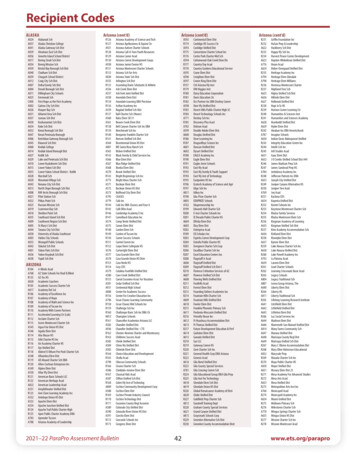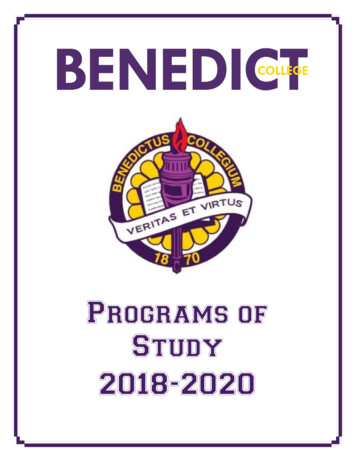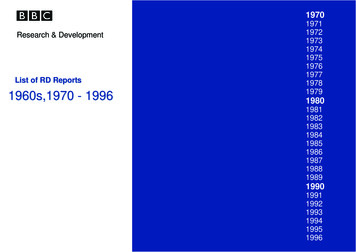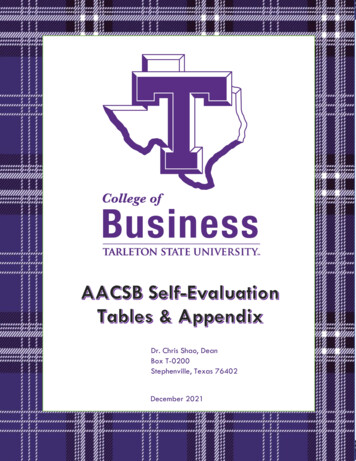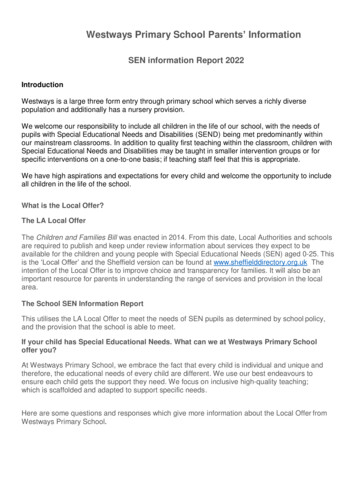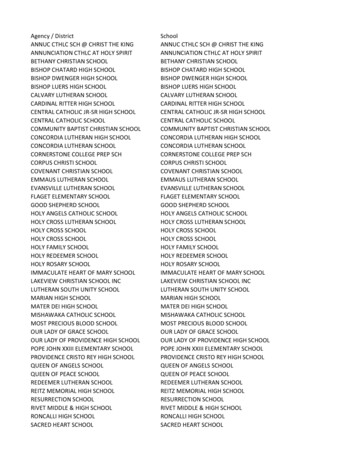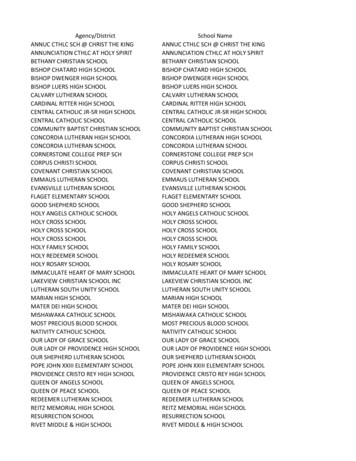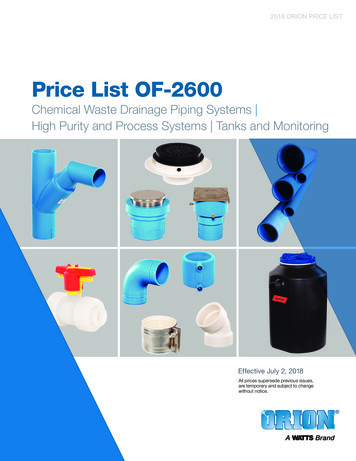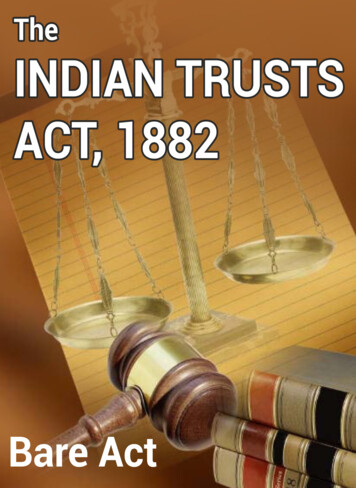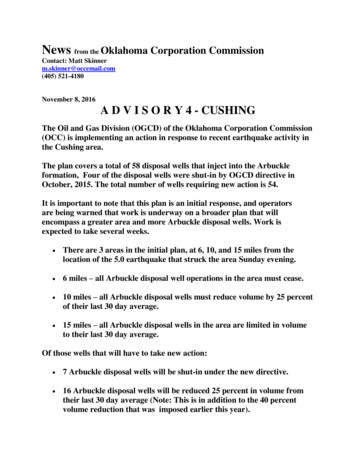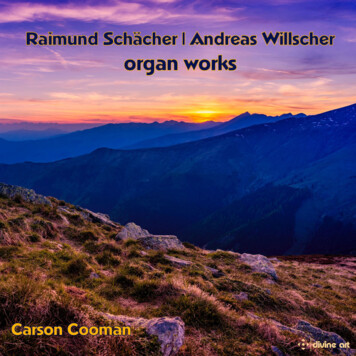
Transcription
Raimund Schächer (b. 1960)123Sonata antiqua, Op. 40 (2004)Präludium antiquumAria irlandese con variazioniPassacaglia in a4Fantasia (Tintinnabuli — Hommage à Arvo Pärt), Op. 23 (1996)5678910Treuchtlinger Partita, Op. 11 (1989)PraeambulumBiciniumPedal-SoloChoral: “Gib dich 11:214:034:1813:107:3217:08Andreas Willscher (b. 1955)111213Suite romantique (1976)ScherzoRomance sans parolesToccata romantique14Aria (1976)15Partita on “Creator alme siderum” (2002)3:164:593:1611:306:0112:00[Introduction] — Andante — Adagio — Scherzando, vivace —Ruhig — Tuba Tune — Andante — Allegrototal playing time:67:28Carson CoomanSonnenorgel of Pfarrkirche St. Peter und Paul, Görlitz, GermanyMathis Orgelbau, 1997/2006 Model by Jiří Žůrek, 2015
The musicThis recording features music by two German composers: Raimund Schächer(b. 1960) and Andreas Willscher (b. 1955). Each composer is represented bythree varied, yet characteristic, pieces. Raimund Schächer’s years of work as aneditor of late medieval and early Renaissance keyboard music show in the freemodality and early-influenced forms of his compositions. Andreas Willscher’sdeep interest in French romanticism and eclectic musical interests (drawing onboth classical and non-classical sources) are displayed in his pieces.Raimund Schächer’s Sonata antiqua, op. 40 (2004) is in three movements, eachof which explores a blend of old and new modality. The opening “Präludiumantiquum” is in triple meter, with rhythms and harmonies reminiscent ofRenaissance dance music. In the second movement, “Aria irlandese convariazioni” (Irish Air with Variations), an original melody (with a British Isles“flavor”) is presented and followed by five variations and a coda (arecapitulation of the first variation). The closing “Passacaglia in a” begins with atwo-voice melody (alluding to the Russian folk song “Song of the VolgaBoatmen”) in the treble and then develops its harmonic implications further in aseries of episodes.Fantasia (Tintinnabuli — Hommage à Arvo Pärt), op. 23 (1996) is inspired bythe “tintinnabuli” modal style of the Estonian composer Arvo Pärt (b. 1935).Pärt’s name for his characteristic style was derived from the Latin word for“bell,” and the harmonic language employs both triadic modal harmonies andgentle dissonant inflections and colorings. Schächer has taken inspiration fromthis distinctive sound world to craft his own fantasia, which maintains atranquil atmosphere throughout.
Treuchchtlinger Partita, op. 11 (1989) takes its name from the Bavarian town ofTreuchtlingen where the composer has lived and worked for many years. Thepartita is in six movements. The opening movement, “Praeambulum,” opensthe work grandly with broadly flowing music. In the second movement,“Bicinium,” an active upper voice accompanies a slower-moving melodic lowervoice. The melody is the hymn “Ist Gott für mich, so trete” (a tune from 16thcentury England first printed as a hymn in Germany in 1609). The thirdmovement is a solo for the pedals alone. Melodic outer sections surround aninner section of faster music. The fourth movement is a lush harmonization ofthe chorale “Gib dich zufrieden” (a melody by Jakob Hinze to words by PaulGerhardt). The fifth movement is a lyrical aria that travels through differentmodes. The final movement is a festive passacaglia inscribed in homage to theBaroque composer Heinrich Ignaz Franz von Biber (1644–1704).Andreas Willscher’s Suite romantique (1976) is an early work, written when thecomposer was 21 and in the initial years of his appointment as organist of St.Francis Church in Hamburg. Influences from French music of the late 19th andearly 20th century have always been a strong part of Willscher’s style, and theyare displayed vividly in the three contrasting movements of this suite:“Scherzo,” “Romance sans paroles” (“Romance without words”), and “Toccataromantique” (“Romantic Toccata”).Aria (1976) is a lyrical and expressive piece. The tranquil opening melody isfollowed by an unexpected section of loud, energetic music. The tension is thenrelaxed again through an interlude of rising fourths and a further developmentof the principal melody (this time sounding in the pedal). The opening musicreturns to close the piece.
Partita on “Creator alme siderum” (2002) is a set of variations on the wellknown plainchant hymn “Creator alme siderum” (“Creator of the Stars”). Thetext was a 1632 revision in the Roman Breviary of the earlier 7th century hymn“Conditor alme siderum.” The text speaks of Jesus as the redeemer of the worldthrough his incarnation, death, resurrection, and the final judgment. While thesentiments in the text apply to the whole Christian faith and year, the hymn iscommonly sung during the season of Advent.Willscher’s variations explore the musical possibilities of the plainchant in awide variety of moods including a quasi-birdsong meditation, a jaunty Englishstyle “tuba tune,” and a festive toccata. (In the fourth scherzando variation, wehear one of the Goerlitz Sonnenorgel’s most unusual “toy” stops: the wild,mechanical Nachtigall.)Notes by Carson Cooman 2018
The composersGerman composer and organist Raimund Schächer (b. 1960) was born inHersbruck and was educated at the Meistersinger-Konservatorium inNuremburg and the Academy for Protestant Church Music in Bayreuth. He hasserved as a church musician in Nuremberg, Pappenheim, Treuchtlingen, andHeidenheim. As a composer, Schächer has written a number of organ, choral,and chamber works. He has also been widely active as an editor of earlykeyboard music, and his editions (many of which are the first modernpublications of the works in question) have been published by Cornetto, Carus,Pro Organo, and Strube Verlag.German composer and organist Andreas Willscher (b. 1955) studiedcomposition, theory, and organ in his native Hamburg. In 1971 he wasappointed organist of the St. Francis Church in Hamburg and in 2000 at thechurch of St. Joseph-Wandsbek. In addition, he has been keyboardist for severaljazz and rock ensembles. Willscher has received many awards and commissionsfor his compositions, which range widely in form: from symphonic music andoratorios to cabaret and rock scores. His organ works are very diverse, rangingfrom large-scale post-tonal pieces to some that blend elements of the traditionalrepertoire with contemporary jazz and pop influences.In addition to his own composition and performing activities, Willscher haspublished a number of literary and scientific articles in journals andencyclopedias and has been very active in collecting and preserving lost andforgotten music from earlier eras. In 1995, Willscher was awarded theSudetendeutscher Culture Prize for Music and in 2012 the Ansgar Medal fromthe Archdiocese of Hamburg for services to church music. In 2015, in honor ofhis 60th birthday and life’s work as a musician, he received the Johann WenzelStamitz Prize from the Arts Guild of Esslingen.
The organistCarson Cooman (b. 1982) is an American composer with a catalog of hundredsof works in many forms—ranging from solo instrumental pieces to operas, andfrom orchestral works to hymn tunes. His music has been performed on all sixinhabited continents in venues that range from the stage of Carnegie Hall to thebasket of a hot air balloon.Cooman’s work appears on over forty recordings, including more than twentycomplete CDs on the Naxos, Albany, Artek, Gothic, Divine Art, Métier,Diversions, Altarus, Convivium, MSR Classics, Raven, and Zimbel labels.Cooman’s primary composition studies were with Bernard Rands, Judith Weir,Alan Fletcher, and James Willey.As an active concert organist, Cooman specializes in the performance ofcontemporary music. Over 300 new works have been composed for him bycomposers from around the world, and his organ performances can be heard ona number of recordings.Cooman is also a writer on musical subjects, producing articles and reviewsfrequently for a number of international publications. He serves as an activeconsultant on music business matters to composers and performingorganizations, specializing particularly in the area of composer estates andarchives.For more information, visit www.carsoncooman.com
The OrganSonnenorgel of Pfarrkirche St. Peter und Paul, Görlitz, Germany(Mathis Orgelbau, 1997/2006)Model by Jiří Žůrek (Institute for Classical Studies,Academy of Sciences of the Czech Republic, Prague), 2015The church of St. Peter and Paul in Görlitz was founded in the 13th century andit attained its present shape in 1497. The central nave is flanked by four aisles,forming a huge and highly reverberant space. In 1691 it was reconstructed aftera fire, and consequently it was given a new organ, finished in 1703 by EugenioCasparini (1623–1706) and his son.The organ had 57 stops on 3 manuals and it was among the largest instrumentsin Silesia. The organ case was designed by the architect Johann Conrad Büchau.The special feature of this facade is the implementation of 17 golden suns,which also sounded as a pedal cornet-mixture of 12 ranks. These suns havegiven name to the instrument: Sun-organ Sonnenorgel. Besides the organ case,only the Cypress-wood pipes of Onda maris have survived from the Caspariniorgan until the present. In 1894, the company Schlag and Sons rebuilt theinstrument. Later in 1928, the company Sauer installed an electo-pneumaticorgan into the historical case.The interior of the church was restored between 1980–92 and there were plansto build a new organ into the historical case. The specification of the newinstrument could not follow Casparini s organ (since none of his instrumentsexists unaltered). Furthermore, the Sauer organ was not suitable for restoration,being only partially preserved after World War II.
The expert committee decided to build an instrument inspired by Casparini sbaroque concept, but enlarged by a swell manual allowing it to also performlater organ music. The work was entrusted to the Swiss company MathisOrgelbau. In 1997, the first part of the instrument was inaugurated: the 3manuals (HW, OW, BW), and the pedal. The construction of the swell divisionwas postponed, and was completed in 2006. The clever voicing of theinstrument and its large, rich specification makes the organ universally suitablefor almost every kind of organ music.(Jiří Žůrek)
Organ specificationHauptwerk (Man. I)Principal 16’Gross-Octava 8’Viol di Gamba 8’Hohl-Flöt 8’Rohr-Flöt 8’Fiffaro 8‘Rohr-Fl.-Quint 6‘Octava 4‘Spitz-Flöt 4‘Salicet 4’Quinta 3’Super-Octava 2’Mixtur IV 2’Cymbel III 1 1/3’Cornet VBombart 16’Trompet 8’Clarin 4’Oberwerk (Man. II)Quintadena 16’Principal 8’Groß-Gedackt 8’Quintadena 8’Onda Maris 8’Octava 4’Rohr-Flöt 4’Zynk II 2 2/3’Sedcima 2’Glöcklein-Thon 2’Vigesima nona 1 1/2'Scharff-Cymbel III 1‘Schwellwerk (Man. III;enclosed)Bordun 16’Viola pomposa 16’Diapason 8’Doppel-Flöt 8’Bordun 8’Salicional 8‘Gamba 8‘Vox coelestis 8‘Principal 4‘Travers-Flöt 4’Viola d’amore 4’Spitz-Flöt 3’Schweitzer-Pfeiff 2’Violine 2‘Piccolo 1‘Mixtur V 2‘Harmonia aeth. III 2 2/3’Bombarde 16’Trompette harm. 8’Hautbois 8’Clarinette 8’Voix humaine 8’Clairon 4’Tremulant
Brustwerk (Man. IV)Gedackt 8’Praestant 4’Ged. Fleut doux 4’Nassat 3’Octava 2’Gemss-Horn 2’Quint-Nassat 1 1/2'Tertia 1 1/2'Super-Sedecima 1‘Scharff-Mixtur III 1 1/3‘Hobois 8‘TremulantPedalGroß Principal-Bass 32’Principal-Bass 16’Contra-Bass 16’Sub-Bass 16’Groß Quinten-Bass 12’Octav-Bass 8’Gemss-Horn-Bass 8’Jubal-Flöt 8’Super-Octav-Bass 4’Jubal-Flöt 4’Bauer-Flöt 2’Mixtur VI 2 2/3’Pedal (cont.)Contra-Posaunen 32‘Posaunen 16‘Fagotti 16‘Trompeten-Bass 8‘Tromba 8’Clarinen-Bass 4’Vox Angelica 2’SonnenmixturNormal Couplers: II-I, III-I, IV-I, IV-II, IV-III, III-II, I-P, II-P, III-P, IV-PSuperoctave: III/P 4’Suboctave: III/I 16’, III/III 16’Toy stops: Cymbelstern; Tamburo; Nachtigall; Vogel-Gesang; Kuckuck
Andreas WillscherRaimund Schächer
Carson Cooman
Also available:Andreas Willscher: Organ Symphony No. 5Carson Cooman,organ of Laurenskerk, RotterdamDIVINE ART DDA 25150“Brilliant and thrilling. the quietest movements are equallyimpressive. Cooman has made an excellent choice ofcombining instrument and repertoire.” – The Whole NoteAndreas Willscher: Organ Symphonies Nos. 19& 20 / The Beatitudes (Die Seligpreisungen)Carson Cooman,Organ of St Bartholomew, ArmleyDIVINE ART DDA 25162“His organ works are especially fine and varied - lively,thrilling works with great rhythmic vitality.” – New ClassicsCarson Cooman Organ Music SeriesVolumes 1-7 now available
This album was recorded in December 2017This recording was produced in live performance via the Hauptwerk system.The virtual model was created as part of the Sonus Paradisi project(www.sonusparadisi.cz).Program notes: Carson CoomanProducer: Travis O. Q. PooheTracks 1-3, 5 published by Strube Verlag; other tracks Copyright ControlCover photograph by Alberto RestifoPhoto of Carson Cooman: Colby CoomanPhoto of organ: Jiří ŽůrekBooklet and packaging design: Stephen SuttonPhotographs are used with kind permission.All images and texts are copyright; all rights reserved. 2018 Diversions LLC (Divine Art Ltd outside USA/Canada)Over 500 titles, with full track details, reviews, artist profiles and audio samples, can be browsed onour website. Available at any good dealer or direct from our online store in CD, 24-bit HD, FLAC andMP3 digital download formats.UK: Divine Art Ltd. email: uksales@divineartrecords.comUSA: Diversions LLC email: find us on facebook, youtube and twitterAll rights reserved. Any unauthorized broadcasting, public performance , copying, duplication or re-recording in any manner is aninfringement of copyright and violation of applicable laws.
Renaissance dance music. In the second movement, "Aria irlandese con . Divine Art, Métier, Diversions, Altarus, Convivium, MSR Classics, Raven, and Zimbel labels. Cooman's primary composition studies were with Bernard Rands, Judith Weir, . Rohr-Flöt 8' Fiffaro 8' Rohr-Fl.-Quint 6' Octava 4' Spitz-Flöt 4' .

